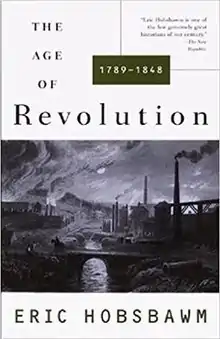The Age of Revolution: Europe 1789–1848
The Age of Revolution: Europe: 1789–1848 is a book by Eric Hobsbawm, first published in 1962. It is the first in a trilogy of books about "the long 19th century" (coined by Hobsbawm), followed by The Age of Capital: 1848–1875, and The Age of Empire: 1875–1914. A fourth book, The Age of Extremes: The Short Twentieth Century, 1914–1991, acts as a sequel to the trilogy.
 First edition | |
| Author | Eric Hobsbawm |
|---|---|
| Country | United Kingdom, United States |
| Language | English |
| Subject | History |
| Publisher | Weidenfeld & Nicolson (UK) World Publishing (US) |
Publication date | 1962 |
| Pages | 366 |
| ISBN | 978-0-679-77253-8 |
| OCLC | 34576637 |
| 940.2/7 20 | |
| LC Class | D299 .H6 1996 |
| Followed by | The Age of Capital: 1848–1875 |
Hobsbawm analysed the early 19th century, and indeed the whole process of modernisation thereafter, using what he calls the twin revolution thesis. This thesis recognised the dual importance of the French Revolution and the Industrial Revolution as midwives of modern European history, and – through the connections of colonialism and imperialism – world history.
Contents
- Part I. Developments
- 1. The World in the 1780s
- 2. The Industrial Revolution
- 3. The French Revolution
- 4. War
- 5. Peace
- 6. Revolutions
- 7. Nationalism
- Part II. Results
- 8. Land
- 9. Towards an Industrial World
- 10. The Career Open to Talent
- 11. The Labouring Poor
- 12. Ideology: Religion
- 13. Ideology: Secular
- 14. The Arts
- 15. Science
- 16. Conclusion: Towards 1848
External links
- The Age of Revolution: Europe 1789–1848 full text on Hathi Trust
- The age of revolution 1789-1848 - Eric Hobsbawm | libcom.org
This article is issued from Wikipedia. The text is licensed under Creative Commons - Attribution - Sharealike. Additional terms may apply for the media files.